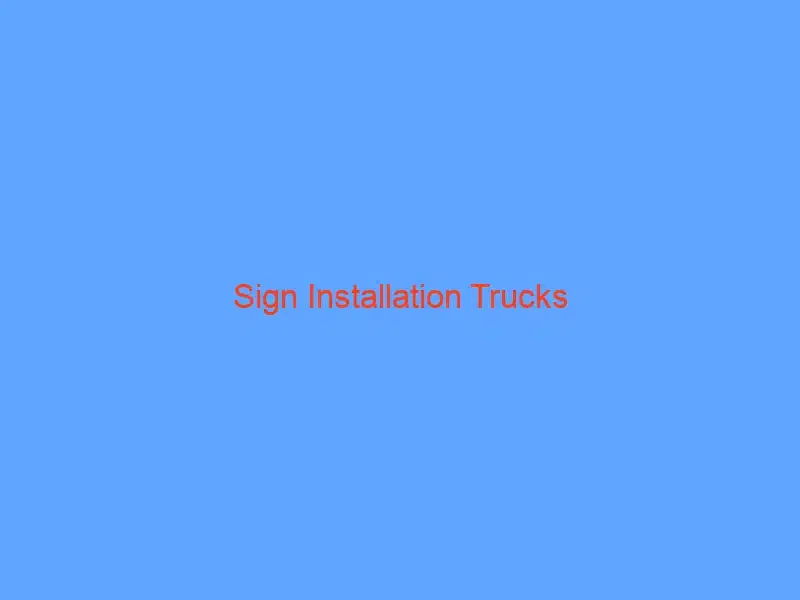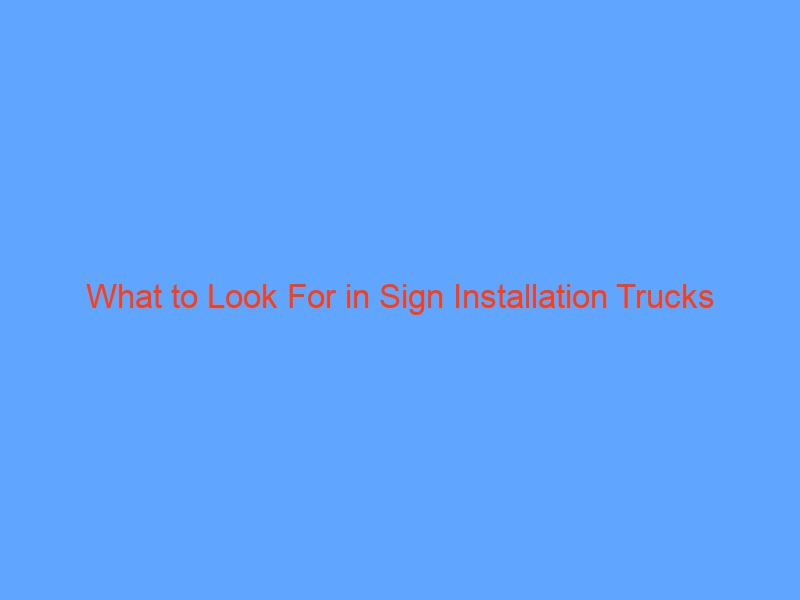Signage is key for businesses looking to establish themselves within their local community, both attracting new customers and reminding existing ones of what the business offers.
Light and sign trucks are built for both installation and service purposes, enabling one operator to safely complete tasks at height. This equipment is essential when working in hard-to-reach places.
Oversized Work Platforms
Oversized work platforms enable one operator to complete both exterior sign installation and service with just one machine, making this type of equipment popular among sign makers. They provide a safe environment in which all tasks required on a site such as mounting new signage, final bolt-ins or weld-ins or even repairing illuminated advertising signs can be safely accomplished.
These vehicles feature an expandable 28″x120″ rotating work platform with a capacity of 900 pounds that is both stowable and expandable – ideal for accommodating workers, tools and materials. Both models offer continuous turret rotation and remote controls for boom operations from the platform; both models also include lockable steel platform control boxes and an EZ-Stow jib winch capable of handling 500lbs stowed within its work platform.
This oversized platform provides ample room to carry various tools onto it, such as a 110 V power cord, welding leads, oxy/acetylene hoses, air hose and pressure washer hose; in addition, an extendable sign fork is located at the front of the platform for carrying channel letters. Furthermore, it’s fully protected with guardrails that meet all ANSI safety standards for ease of rotation and use.
Elliott HiReach models feature zero tailswing and wide side reach to enable sign and lighting work to be completed from a vehicle with less space, thus cutting operating costs, saving time, and increasing productivity. Their main boom can lift multiple people or materials at one time while their work platform platform makes one-truck jobs possible, further increasing productivity while decreasing expenses.
Side Reach
Sign installers working at height require access to equipment they can quickly maneuver into position in order to set up new signs or service existing ones, then return safely and quickly so they can move onto their next job. That is where sign trucks become indispensable – this is why so many businesses invest in such vehicles.
At first, sign installation workers utilized either a block and tackle system or lashed together ladders as means to reach their required elevation for their jobs. As time progressed and signs became increasingly complex and larger, requiring elevating equipment became ever more pressing – especially as more features like changeable copy, moving parts, moulded accents and gilding were being added onto signs.
Sign installation trucks were created in response to this need, beginning as simple scaffolding systems before evolving into more complicated gin poles that used two parallel poles connected by joints to form triangles that could be raised and lowered via pulley systems. Finally, truck-mounted aerial ladders powered either by hand-cranks or electric systems using 12, 110, or (in some rare instances) 220-volt AC became popular solutions.
These units were introduced as replacements to Boatswain chairs, which consisted of swinging planks attached to a crane’s load line cable and had nothing holding them in place except a rope tied around their waists and eventually, safety belts.
Sign installation trucks of today feature articulating booms to accommodate various job requirements. A key feature is side reach, which enables operators to move the bucket away from the center of the vehicle to expand its working range and reach obstructions such as gas pumps, awnings and soffits more effectively.
Versalift, which has been manufacturing articulated telescopic bucket trucks for more than three decades, is committed to helping its customers in the lighting, traffic signal and sign industries find the ideal truck. They offer an extensive variety of truck models and components that allow for both exterior installations as well as service work.
Aerial Lifts
Truck-mounted aerial lifts enable workers to efficiently repair electrical lines or traffic signals with greater access. There are various types of lifts, some more suitable than others for certain jobs; articulated boom lifts have an articulating arm which enables access into tight spaces otherwise impossible for other equipment; these lifts are commonly found on highways and streets with electricity, telephone and cable lines installed.
Straight boom, or telescopic boom lifts are another type of lift available to drivers. They attach directly to a pickup truck’s bed, featuring an extended work platform. Like their counterparts with articulated arms, these straight booms can move into tight spaces but may not be as flexible. Furthermore, these lifts can carry heavier loads up to 1,000 pounds than others on the market.
Straight boom lifts differ from their articulating arm lift counterparts in that there are no hinges in their telescopic extension arm, making them easier to use but limiting how much load they can carry at one time. Furthermore, straight booms typically have reduced reach capabilities than other devices.
Sign companies and other organizations reliant on truck-mounted aerial lifts must select an ideal model based on anticipated usage, required certifications for operators and features available; for instance jib winches are particularly helpful when handling heavy materials like signs or lighting fixtures while integrated radio systems enable hands-free control.
Many of the most widely-used lifts for sign installation and maintenance come from leading manufacturers like Altec, HiReach, Elliott and Ruthmann trucks. These lifts are specifically tailored to meet the industry-specific requirements so operators can complete tasks more quickly and effectively.
Aerial lifts utilized by light and sign companies often come equipped with safety controls in the bucket, 110V outlets, welding leads and 360deg rotation capabilities – features which make it easy for employees to complete tasks in hard-to-reach locations without strain or delay, increasing productivity while helping ensure jobs are done right the first time.
Aerial lifts are essential tools for many types of organizations, from state and local departments of transportation to lighting maintenance contractor groups. Many larger entities keep a fleet of these lifts on hand to manage their workload efficiently – knowing that having reliable lifts at their disposal helps get their tasks completed safely and quickly.





